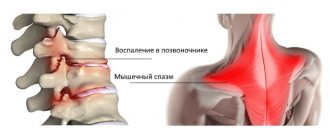Dosage forms and composition
Xefocam contains one active component - lornoxicam, which affects the production of prostaglandins. The drug is produced:
- In tablet form: with a dosage of 4–8 mg. Formative components: silicon dioxide, starch, lactose, magnesium stearate. White oblong pills are packaged in paper cellular blisters of 10 pieces. On the surface they have an engraving Lo and a dose designation - the number 4 or 8. The cardboard packaging of the medicine contains from 10 to 50 tablets.
- In the form of a lyophilisate for the preparation of solutions. Yellow dense mass placed in glass bottles - 5 pieces per package. One container contains a medicine in a dose of 8 mg, auxiliary compounds: mannitol, tromethanol.
Mechanism of action
Lornoxicam belongs to the category of non-opioid analgesics. In the body, it inhibits the activity of the enzyme cyclooxygenase, which is responsible for the synthesis of neurotransmitters of pain and inflammation. It also slows down oxidation reactions. The substance does not affect the thermoregulation center, breathing, the functioning of the cardiovascular system, and does not cause drug dependence.
Xefocam in tablets and solution is quickly absorbed into the blood, binding to its proteins. The analgesic effect is observed after 15–20 minutes, reaching its maximum after 1.5–2 hours. Within 3.5–4 hours, the substance is filtered by liver cells and gradually eliminated from the body through the kidneys and intestines. During its activity and elimination, the drug produces almost no metabolites.
If the instructions are followed, Xefocam does not have a pronounced toxic effect on internal organs. Its components do not accumulate in tissues. The product is approved for use by physical parameters in weakened people, with insufficient liver function and excretory system.
Xefocam®
The risk of ulcerogenic effects of the drug can be reduced by the simultaneous administration of proton pump inhibitors and synthetic prostaglandin analogues. If bleeding occurs in the gastrointestinal tract, the drug should be stopped immediately and appropriate emergency measures taken. It is especially necessary to carefully monitor the condition of those patients with gastrointestinal pathology who are receiving a course of treatment with XEFOCAM for the first time.
Like other oxicams, XEFOCAM inhibits platelet aggregation and may therefore increase bleeding time. When using this drug, carefully monitor the condition of patients who require completely normal functioning of the blood coagulation system (for example, patients who are undergoing surgery), have disorders of the blood coagulation system, or are receiving drugs that inhibit coagulation (including low-dose heparin ), in order to promptly detect signs of bleeding.
If signs of liver damage appear (itching, yellowing of the skin, nausea, vomiting, abdominal pain, dark urine, increased levels of liver transaminases), you should stop taking the drug and consult your doctor.
The drug should not be used simultaneously with other NSAIDs.
The drug can change the properties of platelets, but does not replace the preventive effect of acetylsalicylic acid in cardiovascular diseases.
In patients with impaired renal function caused by large blood loss or severe dehydration, XEFOCAM, as an inhibitor of prostaglandin synthesis, can be prescribed only after hypovolemia and the associated risk of decreased renal perfusion have been eliminated. Like other NSAIDs, XEFOCAM can cause an increase in blood urea and creatinine concentrations, as well as water and sodium retention, peripheral edema, hypertension and other early signs of nephropathy. Long-term treatment of such patients with XEFOCAM can lead to the following consequences: glomerulonephritis, papillary necrosis and nephrotic syndrome with transition to acute renal failure. Patients with a pronounced decrease in renal function should not be prescribed XEFOCAM (see “Contraindications”). In elderly patients, as well as in patients suffering from arterial hypertension and/or obesity, it is necessary to control blood pressure levels. It is especially important to monitor renal function in elderly patients, as well as in patients:
- simultaneously receiving diuretics;
- concurrently receiving medications that can cause kidney damage.
With long-term use of the drug XEFOCAM, it is necessary to periodically monitor hematological parameters, as well as renal and liver function.
The use of the drug may adversely affect female fertility and is not recommended for women planning pregnancy.
When is Xefocam indicated: instructions
Among the indications for taking the medication: pain of various origins, subject to the action of non-steroidal analgesics. Including those caused by:
- rheumatoid arthritis;
- deforming arthrosis;
- gout;
- ankylosing spondylitis.
The medication effectively reduces pain to moderate and moderate-to-severe intensity. Xefocam does not affect the general course of diseases; it is used only for symptomatic therapy: in short courses.
The drug is used with caution for pathologies of the gastrointestinal tract, smoking, alcoholism, heart failure, and diabetes.
Xefocam tablets p/o 8 mg No. 10x1
Product description
Xefocam.
Release form
Film-coated tablets.
Dosage
8 mg. Quantity per package: 10 pcs.
Manufacturer
Takeda GmbH.
INN
Lornoxicam.
FTG
Npvp.
Qualitative and quantitative composition
One film-coated tablet contains 4.00 mg or 8.00 mg of lornoxicam. Excipients with known effect: Each 4 mg tablet contains 94.00 mg of lactose monohydrate. Each 8 mg tablet contains 90.00 mg of lactose monohydrate. For a complete list of excipients, see the “List of excipients” section.
Description
White to off-white with a yellowish tint, oblong film-coated tablets with indentation “L04” (4 mg dosage) and “L08” (8 mg dosage).
Indications for use
— Short-term symptomatic treatment of acute pain syndrome of mild to moderate intensity in adults. — Symptomatic treatment of pain and inflammation in osteoarthritis in adults. — Symptomatic treatment of pain and inflammation in rheumatoid arthritis in adults.
Directions for use and doses
Dosage Regimen For all patients, the appropriate dosage regimen should be based on the individual response to treatment. The risk of adverse effects can be minimized by using the lowest effective dose for the shortest course necessary to control symptoms (see Precautions). Pain syndrome The daily dose of lornoxicam is 8-16 mg, divided into 2-3 doses. The maximum recommended daily dose is 16 mg. Osteoarthritis and rheumatoid arthritis The recommended initial daily dose is 12 mg of lornoxicam, divided into 2-3 doses. The maintenance dose should not exceed 16 mg of lornoxicam per day.
Special patient groups
Pediatric patients Lornoxicam is not recommended for use in children and adolescents under 18 years of age due to the lack of data on safety and effectiveness. Elderly patients For elderly patients over 65 years of age, no special dose adjustment is required, except in cases of existing renal or hepatic impairment. Lornoxicam should be prescribed with caution, since this group of patients is more susceptible to adverse reactions from the gastrointestinal tract (see section "Precautions"). Renal impairment In patients with mild to moderate renal impairment, the maximum recommended daily dose is 12 mg divided into 2 or 3 divided doses (see Precautions). Lornoxicam is contraindicated in patients with severe renal impairment (see section "Contraindications"). Hepatic impairment: In patients with moderate hepatic impairment, the maximum recommended daily dose is 12 mg divided into 2 or 3 divided doses (see section "Precautions"). Lornoxicam is contraindicated in patients with severe liver dysfunction (see section "Contraindications").
Mode of application
Xefocam film-coated tablets are intended for oral administration and should be taken with a sufficient amount of liquid. Contraindications - hypersensitivity to the active substance or to any of the excipients listed in the section “List of excipients”; - thrombocytopenia; - hypersensitivity (symptoms such as asthma, rhinitis, angioedema or urticaria) to other non-steroidal anti-inflammatory drugs (NSAIDs), including acetylsalicylic acid; - severe heart failure; - gastrointestinal bleeding, cerebrovascular hemorrhage or other bleeding; - a history of gastrointestinal bleeding or perforation associated with previous NSAID therapy; - history of acute peptic ulcer/bleeding or recurrent peptic ulcer/bleeding (2 or more clear episodes of confirmed ulceration or bleeding); - severe liver failure; - severe renal failure (serum creatinine >700 µmol/l); third trimester of pregnancy (see section “Period of pregnancy and breastfeeding”).
Precautionary measures
Lornoxicam reduces platelet aggregation and prolongs bleeding time; therefore, caution should be used when prescribing to patients with a tendency to bleed. For the following disorders, lornoxicam should be prescribed only after a careful benefit-risk assessment: - Renal impairment: lornoxicam should be used with caution in patients with mild (serum creatinine 150-300 µmol/l) and moderate (serum creatinine 300-700 µmol/l) renal impairment failure due to the dependence of the maintenance of renal blood flow on the level of renal prostaglandins (see section “Dosage and Administration”). If renal function deteriorates during treatment, treatment with lornoxicam should be discontinued. — Monitoring of renal function is necessary in patients: • undergoing major surgery, • with heart failure, • during concomitant treatment with diuretics or drugs with known or suspected nephrotoxic effects (see section “Interaction with other drugs and other forms of interaction”) . - Patients with bleeding disorders: Close clinical observation and laboratory monitoring (eg, aPTT) is recommended. - Liver failure (for example, with cirrhosis of the liver): in patients with impaired liver function, careful clinical observation and laboratory monitoring should be considered, since after the use of daily doses of 12-16 mg, accumulation of lornoxicam may occur (increase in AUC) (see section " Pharmacokinetics"). In other cases, impaired liver function is unlikely to affect the pharmacokinetics of lornoxicam compared to healthy individuals. - Patients receiving long-term treatment (more than 3 months): when taking NSAIDs, it is recommended to regularly assess renal and liver function, as well as hematological parameters. — Elderly patients over 65 years of age: monitoring of kidney and liver function is recommended. It is recommended to use with caution in elderly patients after surgery. Concomitant use with other NSAIDs Avoid simultaneous use of lornoxicam with NSAIDs, including selective cyclooxygenase-2 inhibitors (see section "Interaction with other medicinal products and other forms of interaction").
Minimizing the risk of unwanted effects
The risk of adverse effects can be minimized by using the lowest effective dose for the shortest course necessary to control symptoms (see Dosage and Administration), and taking into account the gastrointestinal and cardiovascular risks listed below ). Gastrointestinal bleeding, ulceration and perforation Gastrointestinal bleeding, ulceration and perforation: Gastrointestinal bleeding, ulceration or perforation, which can be fatal, has been reported with all NSAIDs. They occurred with or without warning symptoms or a history of serious gastrointestinal complications at any time during therapy. The risk of gastrointestinal bleeding, ulceration or perforation is higher with increasing doses of NSAIDs, in patients with a history of ulcers, especially if they were complicated by bleeding or perforation (see section "Contraindications"), and in elderly patients. In these patients, treatment should be started with the lowest dose possible (see section "Dosage and Administration"). For these patients and for patients requiring concomitant treatment with low-dose acetylsalicylic acid or other drugs that may increase the risk of gastrointestinal adverse reactions, combination therapy with gastroprotective agents (eg, misoprostol or proton pump inhibitors) should be considered (see information below, as well as the section “Interaction with other medicinal products and other forms of interaction”). Regular monitoring by a doctor is recommended. Patients with a history of gastrointestinal toxicity, especially the elderly, should be instructed to report all unusual abdominal symptoms (especially signs of gastrointestinal bleeding); especially at the beginning of treatment. Caution should be exercised in patients concomitantly taking medications that increase the risk of ulceration or bleeding, such as oral corticosteroids, anticoagulants (such as warfarin), selective serotonin reuptake inhibitors, or antiplatelet agents (such as acetylsalicylic acid) (see Interactions with Others). drugs and other forms of interaction"). If gastrointestinal bleeding or ulceration occurs in patients taking lornoxicam, treatment should be interrupted. NSAIDs should be used with caution in patients with a history of gastrointestinal diseases (ulcerative colitis, Crohn's disease), as their use may cause an exacerbation of the disease (see section "Side effects"). Elderly patients Elderly patients have an increased incidence of adverse reactions to NSAIDs, primarily gastrointestinal bleeding and perforation, which can be fatal (see section "Dosage and Administration"). Cardiovascular and Cerebrovascular Effects Adequate monitoring and instruction are required in patients with a history of or active hypertension and/or heart failure, as fluid retention and edema have been described in association with NSAID therapy. Clinical studies and epidemiological data indicate that the use of some NSAIDs, particularly at high dosages and during long-term treatment, may be associated with an increased risk of arterial thrombotic complications (eg, myocardial infarction and stroke). The available data are insufficient to exclude such a risk for lornoxicam. The use of lornoxicam in patients with uncontrolled hypertension, chronic heart failure, established coronary artery disease, peripheral arterial disease and/or cerebrovascular disease should only be undertaken after a careful assessment of the benefits and risks. Such an assessment should be made before initiating long-term treatment in patients with risk factors for cardiovascular disease (eg, hypertension, hyperlipidemia, diabetes mellitus, smoking). Concomitant treatment of NSAIDs and heparin in connection with spinal or epidural anesthesia increases the risk of spinal/epidural hematomas (see section "Interaction with other medicinal products and other forms of interaction"). Skin and subcutaneous tissue disorders Severe, sometimes fatal skin reactions, including exfoliative dermatitis, Stevens-Johnson syndrome, toxic epidermal necrolysis, have been very rarely reported in association with the use of NSAIDs (see section "Side effects"). The highest risk for such reactions exists at the beginning of therapy, in most cases in the first month of treatment. At the first appearance of a skin rash, damage to the mucous membranes or other signs of increased individual sensitivity, lornoxicam should be discontinued. Respiratory system disorders: Caution should be used in patients suffering from bronchial asthma or with a history of asthma, as it has been reported that NSAIDs may cause bronchospasm in such patients. Systemic lupus erythematosus and mixed connective tissue disease Caution should be exercised in patients with systemic lupus erythematosus (SLE) and mixed connective tissue disease due to the increased risk of aseptic meningitis. Nephrotoxicity Concomitant use of NSAIDs and tacrolimus may increase the risk of nephrotoxicity due to decreased renal prostacyclin synthesis. In patients receiving such combination therapy, renal function should be carefully monitored (see section "Interaction with other medicinal products and other forms of interaction"). Laboratory Abnormalities As with most other NSAIDs, increases in serum concentrations of transaminases, bilirubin, or other liver function tests, as well as increases in creatinine, blood urea nitrogen, and other laboratory changes have been reported. If these abnormalities become significant or persist, use of lornoxicam should be discontinued and appropriate evaluation performed. Lactose This medicine contains lactose. Patients with rare hereditary galactose intolerance, lactase intolerance and glucose-galactose malabsorption should not take this medicinal product. Fertility The use of lornoxicam, like any other medicinal product known to inhibit cyclooxygenase/prostaglandin synthesis, may have a negative effect on fertility and is therefore not recommended for use in women planning pregnancy. For women experiencing difficulty becoming pregnant or undergoing evaluation for infertility, discontinuation of lornoxicam should be considered (see section "Pregnancy and Breastfeeding"). Chickenpox In exceptional cases, chickenpox can lead to serious infectious complications of the skin and soft tissues. It still cannot be ruled out that NSAIDs may worsen the course of these infections. Therefore, it is advisable to avoid the use of lornoxicam for chickenpox.
Interaction with other drugs and other forms of interaction
Concomitant use of lornoxicam with: - cimetidine: leads to increased plasma concentrations of lornoxicam, which may increase the risk of side effects of lornoxicam (no interactions have been detected between lornoxicam and ranitidine or between lornoxicam and antacids). - anticoagulants: NSAIDs may enhance the effect of anticoagulants such as warfarin (see section "Precautions"). INR control is indicated. - phenprocoumon: decreased effectiveness of treatment with phenprocoumon. - heparin: NSAIDs, when used simultaneously with heparin in connection with spinal or epidural anesthesia, increase the risk of bleeding, as well as spinal or epidural hematomas (see section "Precautions"). - ACE inhibitors: the antihypertensive effect of ACE inhibitors may be reduced. - diuretics: decreased diuretic and antihypertensive effects of loop, thiazide and potassium-sparing diuretics (increased risk of hyperkalemia and nephrotoxicity). - beta blockers: decreased antihypertensive effect. - angiotensin II receptor blockers: decreased antihypertensive effect; - digoxin: decreased renal clearance of digoxin, which increases the risk of digoxin toxicity. - corticosteroids: increased risk of gastrointestinal ulceration or bleeding (see section "Precautions"). - quinolone antibiotics (for example, levofloxacin, ofloxacin): increased risk of seizures. - antiplatelet agents (for example, clopidogrel): increased risk of bleeding (see section "Precautions"). - other NSAIDs: increased risk of gastrointestinal bleeding and ulceration. - methotrexate: increased serum methotrexate levels. This may lead to increased toxicity. If concomitant therapy is necessary, careful monitoring should be considered. - selective serotonin reuptake inhibitors: increased risk of bleeding (see section "Precautions"). - Lithium: NSAIDs inhibit the renal clearance of lithium and thus may increase serum lithium concentrations beyond toxic limits. Therefore, it is necessary to monitor serum lithium levels, especially during initiation of treatment, when adjusting the dose or discontinuing treatment. - cyclosporine: increased concentration of cyclosporine in the blood serum. The renal toxicity of cyclosporine may be enhanced by effects that are mediated by renal prostaglandins. When combined therapy, it is necessary to monitor renal function. - sulfonylureas (for example, glibenclamide): increased risk of hypoglycemia. - known inducers and inhibitors of CYP2C9 isoenzymes: lornoxicam (like other NSAIDs dependent on cytochrome P450 2C9 (CYP2C9 isoenzyme) interacts with known inducers and inhibitors of CYP2C9 isoenzymes (see section "Pharmacokinetics" Biotransformation). - tacrolimus: increases the risk of renal toxicity in connection with a decrease in the synthesis of prostacyclin in the kidneys. When used together, it is necessary to monitor renal function (see section "Precautions") - pemetrexed: NSAIDs may reduce the renal clearance of pemetrexed and thus increase renal and gastrointestinal toxicity and lead to myelosuppression. When taking Xefocam with food, the absorption of lornoxicam slows down. As a result, Xefocam should not be taken with food if a rapid onset of analgesic effect is required. Food can reduce the absorption of the drug by approximately 20% and increase Tmax (see section “Pharmacokinetics” Biotransformation)
Pregnancy and breastfeeding period
Pregnancy Lornoxicam is contraindicated in the third trimester of pregnancy (see section "Contraindications"), it should also not be used in the first and second trimester of pregnancy and during childbirth, since there are no clinical data on treatment during pregnancy. There are no sufficient data on the use of lornoxicam in pregnant women. Experimental studies in animals have demonstrated reproductive toxicity of the drug (see section "Preclinical safety data"). Inhibition of prostaglandin synthesis may have a negative effect on pregnancy and/or embryonic/fetal development. Data from epidemiological studies indicate an increased risk of miscarriage and cardiac malformations after the use of prostaglandin synthesis inhibitors in early pregnancy. It is assumed that the risk increases with increasing dose and duration of treatment. In animals, administration of a prostaglandin synthesis inhibitor resulted in increased pre- and postimplantation loss and increased embryofetal mortality. Prostaglandin synthesis inhibitors should not be used during the first and second trimesters of pregnancy, unless clearly necessary. During the third trimester of pregnancy, prostaglandin synthesis inhibitors can cause fetal cardiopulmonary toxicity (with premature closure of the ductus arteriosus and pulmonary hypertension) and cause renal dysfunction, which can progress to renal failure with oligohydramnios. During late pregnancy in both mother and newborn, prostaglandin synthesis inhibitors may prolong bleeding time and inhibit uterine contractions, which may delay or prolong labor. Therefore, the use of lornoxicam is contraindicated in the third trimester of pregnancy (see section “Contraindications”). Breastfeeding There are no data on the excretion of lornoxicam into human milk. In rats during lactation, lornoxicam passes into mother's milk in relatively high concentrations. Lornoxicam should not be used by breastfeeding women. Fertility The use of lornoxicam, like any other medicinal product known to inhibit cyclooxygenase/prostaglandin synthesis, may have a negative effect on fertility and is therefore not recommended for use in women planning pregnancy. For women experiencing difficulty becoming pregnant or undergoing evaluation for infertility, discontinuation of lornoxicam should be considered.
Impact on the ability to drive vehicles or other machinery
Patients who experience dizziness and/or drowsiness during treatment with lornoxicam should refrain from driving or using other machinery.
Side effect
The most common adverse reactions of NSAIDs are reactions from the gastrointestinal tract. Peptic ulcers, perforation or gastrointestinal bleeding may develop, in some cases life-threatening, especially in elderly patients (see section "Precautions"). After using NSAIDs, nausea, vomiting, diarrhea, flatulence, constipation, dyspepsia, abdominal pain, melena, hematemesis, ulcerative stomatitis, exacerbation of colitis and Crohn's disease were observed (see section "Precautions"). In more rare cases, gastritis developed. About 20% of patients taking lornoxicam may experience adverse reactions. The most common adverse reactions when taking lornoxicam were nausea, dyspepsia, indigestion, abdominal pain, vomiting and diarrhea. In general, available clinical trial results indicate the development of these symptoms in less than 10% of patients. During treatment with NSAIDs, cases of edema, arterial hypertension, and heart failure have been reported. Clinical studies and epidemiological data indicate that the use of some NSAIDs (especially in high doses and during long-term treatment) may increase the risk of arterial thrombosis (for example, myocardial infarction or stroke) (see section "Precautions"). Severe infectious complications of the skin and soft tissues can occur extremely rarely due to chickenpox. Below are data on adverse reactions that were detected in more than 0.05% of 6417 patients after taking the drug lornoxicam during phases II, III and IV clinical trials. Adverse reactions are classified depending on the frequency of occurrence: very often (≥1/10); often (≥1/100,
Overdose
There are currently no data on acute overdose of lornoxicam to describe the consequences of overdose or to recommend specific treatments. However, with an overdose of lornoxicam, the following symptoms may be observed: nausea, vomiting, cerebral symptoms (dizziness, blurred vision). Severe symptoms may also occur, such as ataxia to the point of coma and seizures, liver and kidney damage, and possibly coagulation disorders. In case of actual or suspected overdose, the drug should be discontinued. Lornoxicam is rapidly eliminated from the body due to its short half-life. Lornoxicam is not eliminated by dialysis. A specific antidote is still unknown. Routine emergency measures, including gastric lavage, should be considered. Based on general principles, the use of activated carbon only when taken immediately after taking lornoxicam may lead to a decrease in the absorption of the drug. Gastrointestinal disorders, for example, can be treated with prostaglandin analogues or ranitidine.
Pharmacotherapeutic group
Nonsteroidal anti-inflammatory and antirheumatic drugs, oxicams. ATX code: M01AC05
Pharmacological properties
Pharmacodynamics
Mechanism of action Lornoxicam belongs to the oxicam class of NSAIDs with analgesic properties. The mechanism of action of lornoxicam is based on the suppression of prostaglandin synthesis (inhibition of the activity of cyclooxygenase isoenzymes), which leads to desensitization of peripheral pain receptors and, accordingly, to inhibition of inflammation. It also suggests a central effect on pain perception independent of anti-inflammatory effects. Pharmacodynamic properties Lornoxicam does not affect vital signs of the body (for example, body temperature, respiratory rate, heart rate, blood pressure, ECG, spirometry). Clinical efficacy and safety The analgesic effects of lornoxicam were successfully demonstrated in several clinical trials during drug development. When treated with lornoxicam, as with other NSAIDs, common adverse effects are gastrointestinal complications due to local gastrointestinal irritation and systemic ulcerogenic effects, which are mediated by inhibition of prostaglandin synthesis.
Pharmacokinetics
Absorption Lornoxicam is rapidly and almost completely absorbed from the gastrointestinal tract. Maximum plasma concentrations are reached after approximately 1-2 hours. The absolute bioavailability of lornoxicam is 90-100%. There is no first-pass effect of the drug through the liver. Concomitant use of lornoxicam with food reduces Cmax by approximately 30% and increases Tmax from 1.5 hours to 2.3 hours. Absorption of lornoxicam (calculated by AUC) may be reduced by 20%. Distribution Lornoxicam is present in plasma unchanged and also in the form of a hydroxylated metabolite. The degree of binding of lornoxicam to plasma proteins is 99% and does not depend on concentration. After repeated dosing, it is also found in the synovial fluid. Biotransformation Lornoxicam undergoes extensive metabolism in the liver, primarily through hydroxylation to the inactive metabolite 5-hydroxylornoxicam. The CYP2C9 isoenzyme is involved in the biotransformation of lornoxicam. Due to genetic polymorphism for this enzyme, there are slow and rapid metabolizers, so slow metabolizers may experience significantly increased levels of lornoxicam in the blood plasma. The hydroxylated metabolite does not exhibit pharmacological activity. Lornoxicam is completely metabolized, with approximately 2/3 excreted by the liver and approximately 1/3 by the kidneys in the form of an inactive substance. In animal studies, lornoxicam did not induce liver enzymes. In clinical studies, no accumulation of lornoxicam was observed after repeated use at recommended doses. This result was confirmed by drug monitoring data in one-year studies. Elimination The average half-life of the parent substance is 3-4 hours. After oral administration, approximately 50% is excreted in the feces and 42% by the kidneys, mainly in the form of 5-hydroxylornoxicam. The half-life of 5-hydroxylornoxicam after a single or twice daily parenteral dose is approximately 9 hours. There is no evidence of changes in the rate of elimination with repeated use. In elderly patients over 65 years of age, clearance is reduced by 30-40%. Apart from a reduction in clearance, no significant changes in the kinetic profile of lornoxicam were observed in elderly patients. There are no significant changes in the kinetic profile of lornoxicam in patients with renal or hepatic impairment, with the exception of accumulation in patients with chronic liver disease after 7 days of treatment with a daily dose of 12 mg and 16 mg.
Preclinical safety data
Preclinical data based on conventional safety pharmacology, repeated dose toxicity, genotoxicity, and carcinogenic potential studies have not identified specific hazards to humans. Lornoxicam caused renal toxicity and gastrointestinal ulceration in single- and repeated-dose toxicity studies in several species. In rats, lornoxicam reduces fertility (affects ovulation and implantation) and affects pregnancy and childbirth. In rabbits and rats, lornoxicam causes premature closure of the ductus arteriosus due to inhibition of cyclooxygenase. It has been demonstrated that in animals, the administration of prostaglandin synthesis inhibitors leads to increased loss before and after implantation and death of the fetal embryo. In addition, an increase in the incidence of various malformations, including cardiovascular diseases, has been reported in animals treated with a prostaglandin synthesis inhibitor during the organogenetic period.
List of excipients
Core: Magnesium stearate Povidone (K 25) Sodium croscarmellose Cellulose Lactose monohydrate Shell: Macrogol (6000) Titanium dioxide E171 Talc Hypromellose
Incompatibility
Not applicable.
Best before date
3 years.
Storage conditions
Store at a temperature not exceeding 30°C. Keep out of the reach of children.
Release form
Film-coated tablets 4 mg and 8 mg. 10 tablets in a blister made of aluminum foil and PVC film. 1 blister with instructions for use is placed in a cardboard box.
Disposal precautions
No special requirements.
Conditions for dispensing from pharmacies
By doctor's prescription.
Buy Ksefokam tablet p/pl.ob. 8 mg per bl. in pack No. 10x1 in the pharmacy
Price for Ksefokam tablet p/pl.ob. 8 mg per bl. in pack №10x1
Instructions for use for Xefocam tablet p/pl.ob. 8 mg per bl. in pack №10x1
To whom is Xefocam contraindicated?
It is necessary to stop using an analgesic:
- with bronchial asthma complicated by polyposis;
- for erosive and ulcerative lesions of the mucous membranes of the stomach and intestines;
- internal bleeding, suspicion of its presence;
- decreased blood clotting, impaired hematopoietic functions;
- Crohn's disease;
- in the period after heart surgery;
- in case of severe liver dysfunction: cirrhosis, acute hepatosis, hepatitis;
- in case of individual intolerance or allergic reactions to the drug.
Contraindications also include: all stages of pregnancy, children under 18 years of age.
Directions for use and doses
Inside.
Take before meals with a glass of water.
For severe pain: the recommended dose is 8–16 mg/day, divided into 2–3 doses; the maximum daily dose is 16 mg.
For inflammatory and degenerative rheumatic diseases: the recommended initial dose is 12 mg; the standard dose is 8–16 mg/day, depending on the patient’s condition.
The duration of therapy depends on the nature and course of the disease.
For diseases of the gastrointestinal tract, patients with impaired renal or liver function, elderly people (over 65 years old), after major operations, a maximum daily dose of 12 mg is recommended, divided into 3 doses during the day.
To reduce the risk of developing adverse events from the gastrointestinal tract, the minimum effective dose should be used for the shortest possible short course.
Side effects of the drug
Occasionally, while using Xefocam, nausea, dry mouth, decreased appetite, abdominal cramps, and swelling occur. In isolated cases, it is also possible:
- physical weakness, drowsiness;
- weight loss;
- increased irritability;
- the appearance of stomatitis;
- exacerbation of gastritis.
Overdose increases the risk of internal bleeding and perforation of a stomach ulcer.
Xefocam lyophilisate (solution)
In each particular category, side effects are grouped by system-organ class and presented in descending order of frequency: very often (≥ 1/10); often (≥ 1/100 to < 1/10); uncommon (≥ 1/1000 to < 1/100); rare (≥ 1/10,000 to < 1/1000); very rare (< 1/10,000), unknown (cannot be estimated based on available data).
Infectious and parasitic diseases
Rarely: pharyngitis.
Blood and lymphatic system disorders
Rarely: anemia, thrombocytopenia, leukopenia, increased bleeding time.
Very rare: ecchymosis. NSAIDs have been reported to cause potentially severe hematological disorders, such as neutropenia, agranulocytosis, aplastic anemia and hemolytic anemia (class-specific effects).
Immune system disorders
Rarely: hypersensitivity, anaphylactoid and anaphylactic reactions.
Metabolic and nutritional disorders
Uncommon: anorexia, weight change.
Mental disorders
Uncommon: sleep disturbance, depression.
Rarely: confusion, nervousness, agitation.
Nervous system disorders
Often: short-term headaches of low intensity, dizziness.
Rarely: somnolence, paresthesia, taste disturbance, tremor, migraine.
Very rare: aseptic meningitis in patients with SLE and mixed connective tissue diseases.
Visual disorders
Uncommon: conjunctivitis.
Rarely: visual disturbances.
Hearing and labyrinth disorders
Uncommon: dizziness, tinnitus.
Heart disorders
Uncommon: palpitations, tachycardia, edema, heart failure.
Vascular disorders
Uncommon: flushing of the face, swelling.
Rarely: arterial hypertension, bleeding, hematoma.
Respiratory, thoracic and mediastinal disorders
Uncommon: rhinitis.
Rarely: dyspnea, cough, bronchospasm.
Gastrointestinal disorders
Common: nausea, abdominal pain, dyspepsia, diarrhea, vomiting.
Uncommon: constipation, flatulence, belching, dry mouth, gastritis, gastric ulcer, epigastric pain, duodenal ulcer, oral ulceration.
Rarely: melena, hematemesis, stomatitis, esophagitis, gastroesophageal reflux, dysphagia, aphthous stomatitis, glossitis, perforated peptic ulcer, gastrointestinal bleeding.
Disorders of the liver and biliary tract
Uncommon: increased liver function tests, alanine aminotransferase (ALT) or aspartate aminotransferase (AST).
Rarely: liver dysfunction.
Very rare: damage to hepatocytes. Hepatotoxicity, which can lead to liver failure, hepatitis, jaundice and cholestasis.
Skin and subcutaneous tissue disorders
Uncommon: rash, itching, sweating, erythematous rash, urticaria, Quincke's edema, alopecia.
Rarely: dermatitis and eczema, purpura.
Very rare: edema, bullous reactions, Stevens-Johnson syndrome, toxic epidermal necrolysis.
Musculoskeletal and connective tissue disorders
Uncommon: arthralgia.
Rarely: bone pain, muscle spasms, myalgia.
Renal and urinary tract disorders
Rarely: nocturia, urinary disorders, increased levels of urea and creatinine in the blood.
Very rare: In patients with pre-existing renal impairment who require renal prostaglandins to maintain renal blood flow, lornoxicam may precipitate acute renal failure. Nephrotoxicity in various forms, including nephritis and nephrotic syndrome, is a class-specific effect of NSAIDs.
General and administration site disorders
Uncommon: malaise, facial swelling.
Rarely: asthenia.
How to use Xefocam
The medication in tablets is prescribed to adults at 4–8 mg per day. The maximum dose per day is 16 mg. The pills should be swallowed without chewing, with 50–100 ml of water. It is important to follow the regimen, taking the medicine orally before meals - 30–40 minutes. Food slows down absorption and reduces the activity of the analgesic in severe pain.
Xefocam injections are given intramuscularly or intravenously. A single dose of the drug is 8 mg. Before administration, the lyophilisate from the bottle is diluted with distilled water in a volume of 2 ml. If necessary, the injection of the drug is repeated after 4–6 hours.
Pharmacokinetics
Lornoxicam is quickly and almost completely absorbed from the gastrointestinal tract after oral administration. In this case, Cmax in plasma is achieved in approximately 1–2 hours. Food intake reduces Cmax by 30% and increases Tmax up to 2.3 hours. The absolute bioavailability of lornoxicam is 90–100%. Lornoxicam is present in plasma mainly unchanged and, to a lesser extent, in the form of a hydroxylated metabolite, which has no pharmacological activity. The binding of lornoxicam to plasma proteins (mainly to the albumin fraction) is 99% and does not depend on its concentration.
T1/2, on average, is 4 hours and does not depend on the concentration of the drug. Lornoxicam is completely metabolized in the liver. The isoenzyme CYP2C9 is involved in metabolism. Approximately 1/3 of the metabolites are excreted from the body by the kidneys and 2/3 by bile. In elderly people, as well as in patients with renal or hepatic insufficiency, no significant changes in the pharmacokinetics of lornoxicam were found.
Compatibility of the drug with alcohol and other medications
During the period of use of the medication, alcohol should be avoided, since ethanol greatly enhances its toxic effect. Caution is necessary when using Xefocam simultaneously with Cimetidine, Heparin, Methotrexate, Corticotropin, diuretics, antihypertensive drugs from the group of beta blockers and ACE inhibitors. As a result of their combination, a mutual increase in toxicity is likely.
Xefocam is not recommended to be combined with other non-steroidal analgesics, since all of them are characterized by an anticoagulant effect - a decrease in blood clotting.
During the treatment period, you should also refrain from driving a car or operating complex equipment. Xefocam affects the speed of motor skills and mental reactions, which increases the risk of accidents.
Interaction
With the simultaneous use of the drug Xefocam® and
cimetidine - increased plasma concentrations of lornoxicam;
ranitidine and antacid drugs - no interaction detected;
anticoagulants or platelet aggregation inhibitors - possible increase in bleeding time (increased risk of bleeding, MHO control is required);
β-blockers and ACE inhibitors - their hypotensive effect may be reduced;
diuretics - decreased diuretic effect and hypotensive effect;
digoxin - decreased renal clearance of digoxin;
quinolone antibiotics - increased risk of developing seizures;
other NSAIDs or corticosteroids - increased risk of gastrointestinal bleeding;
methotrexate - increased concentration of methotrexate in serum;
SSRIs (for example, citalopram, fluoxetine, paroxetine, sertraline) - increased risk of gastrointestinal bleeding;
lithium salts - it is possible to increase peak plasma lithium concentrations and thereby increase the known side effects of lithium;
cyclosporine - increased nephrotoxicity of cyclosporine;
sulfonylurea derivatives - enhancing the hypoglycemic effect of the latter;
alcohol, corticotropin, potassium supplements - increased risk of side effects from the gastrointestinal tract;
cefamandole, cefoperazone, cefotetan, valproic acid - increased risk of bleeding.







